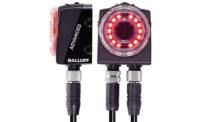Whether fully automatic, semiautomatic or manual, almost every assembly system has some type of sensor for inspection, error-proofing or production monitoring. Thanks to new technologies, sensors are becoming smaller, more robust, more accurate and easier to integrate.
The following is a sampling of some of the latest innovations.
Wireless Controller for IIoT
Banner Engineering has introduced the Sure Cross DXM100 industrial wireless controller, which facilitates communications for Ethernet connectivity or Industrial Internet of Things (IIoT) applications. Available with an internal Sure Cross DX80 wireless gateway or a MultiHop data radio, this powerful Modbus communications device reliably connects local wireless networks with the Internet or host systems.
To satisfy multiple application requirements, the controller offers several wired and wireless connectivity options to easily share data between local and remote equipment. The cellular modem option eliminates the need for IT infrastructures to connect remote equipment, while the integrated Sure Cross wireless radio option enables Modbus connectivity to equipment.
“By integrating Banner’s wireless radio, cellular connectivity and local I/O, our new DXM100 wireless controller provides a proven platform for IIoT applications,” says Tim Hazelton, wireless product manager at Banner. “With unique Internet messaging tools and easy programming capabilities, the DXM100 ensures complete connectivity and communication.”
The device includes a logic controller with easy programming options for simple operation and guaranteed control. It can be programmed using action rules and ScriptBasic, allowing freedom when creating custom sensing and control sequences. The device also allows for secure email and text messaging for alarms, alerts and data log files.
It incorporates several automation protocols into its system, including Modbus RTU, Modbus TCP and EtherNet/IP. The controller also features on-board universal and programmable I/O ports for simple connection to local sensors, indicators and control equipment.
Designed with an interactive, programmable user interface consisting of an LCD screen and four LED indicators, operators can quickly access system status and setup; view selected events or data; and perform site surveys.
For more information, call Banner Engineering at 888-373-6767 or visit www.bannerengineering.com.
Photoelectric Sensors for Many Applications
SICK’s new H18 SureSense family of photoelectric sensors provide reliable object detection in a wide range of sensing applications. For optimal performance at all times, the sensors’ signal strength light bar immediately alerts engineers when maintenance or alignment is an issue. In addition, the sensors are constructed with SICK’s proprietary VISTAL housing, which is said to be as tough as steel.
The sensor family also includes variants that are rated IP 69K to stand up to the most punishing environments, reducing replacement costs and downtime. With a wide variety of standard options to choose from, the sensors can be configured to meet each application’s needs.
Because of the sensor’s flexibility and options, engineers can standardize on a single sensor family to detect all object types, from basic to advanced applications. Featuring background-suppression technology, the sensors can reliably detect nearly any object in any environment, ensuring machines and lines stay up and running at full capacity.
For more information, call SICK at 952-829-4728 or visit www.sickusa.com.
Low-Cost Vision Sensor
The SBSI series of low-cost vision sensors from Festo Corp. can be used for code reading and quality inspection. Featuring fast setup; a compact, rugged IP67 housing; built-in lighting; and EtherNet/IP capability, the device enables OEMs to easily integrate vision sensing into their applications. The sensors can be ordered as components; parts of a subsystem ready for assembly; or incorporated into a plug and play module.
The SBSI-B model reads 1D and 2D codes printed on labels or packaging. These code readers can be used to identify, track and trace products for production flow, logistics and serialization. The sensor can also read codes marked directly on parts, including both laser-etched and dot-peened codes, and can inspect the quality of the marking. The sensor reads up to 10 codes per image.
The SBSI-Q for quality inspection can be used for completeness and presence sensing to ensure all relevant parts are mounted and accounted for. For example, the sensor can determine whether a blister pack of tablets is complete or a package label is printed correctly. Position checking can verify if caps are correctly mounted or screws and holes are in the right position. Fill-level control can ascertain that the correct amount of liquid, powder or pills are in a bottle. This sensor can compare an object’s contour with taught-in reference contour, and can compare patterns and evaluate pixels within the search area by calculating contrast, brightness, or variations in gray scale.
Optics are available for a range of reading areas and working distances. Code-reading models have enhanced depth of field to increase the area of focus. Built-in lighting comes in white, red or infrared. There are also a range of options for additional lighting, including ring lights and area lights. All additional lights are plug-and-play. The housing is small and rugged with an IP67 rating, which is ideal for automotive, food and beverage applications.
All key functions—including processing, lighting and optics—are integrated. There are status and I/O indications. Working distance is adjustable. SBSI sensors have two inputs and four outputs with two PNP/NPN switchable I/O. Engineers have many options for communications protocols, including Industrial Ethernet, EtherNet/IP, TCP/IP, FTP, SMB-digital I/O, RS232 and RS422. The software is intuitive to use, with setup only requiring three to four steps.
For more information, call Festo at 800-993-3786 or visit www.festo.com/us.
Photoelectrics for Harsh Environments
The BOS 18E photoelectric sensors from Balluff Inc. are suitable for use in harsh environments.
With a housing made of 316L stainless steel, they carry an IP 69K or IP 68 rating to withstand high-pressure wash down. They are available with threaded (M18) or smooth bodies, and their hygienic design has ECOLAB approval.
Two diffuse sensor models are available: one with a range of up to 0.25 meter, the other with a range of 0.5 meter. The retroreflective model emits a polarized red light and has a maximum range of 5 meters. The through-beam model has a maximum range of 20 meters.
For more information, call Balluff at 800-543-8390 or visit www.balluff.com.
Inductive Prox Sensors
Baumer Ltd. has introduced three new models in its line of AlphaProx inductive sensors.
The sensors are available in diameters of 6.5 millimeters, M8 and M12, with sensing ranges of 3 and 6 millimeters. This long range allows the sensors to be mounted at a greater safety distance from the object. Even in critical applications, such as the measurement of the deformation of a saw blade, they are optimally protected from mechanical damage.
The 6.5-millimeter and M8 diameter models are only 30 millimeters long. This allows the sensors to be installed even in cramped and inaccessible parts of a machine.
For more information, call Baumer at 860-621-2121 or visit www.baumer.com.
Compact Luminescence Sensors
DK50-UV luminescence sensors from Pepperl+Fuchs can be used for inspecting, sorting, measuring and positioning materials that blend into a background or are invisible. They detect fluorescent chalk marks, clear glue, tamper-proof seals and other marks that regular contrast sensors cannot, even on irregular backgrounds.
The devices have a sensing range of 600 millimeters in a space-saving housing that is 50 percent smaller than previous-generation luminescence sensors. A light spot with a small focal point enables the sensor to detect small things, such O-rings, pin-point leaks and invisible marks as small as 2.2 millimeters in diameter. These sensors are UL- and cUL-listed.
“Because color and contrast sensors do not operate on the visible light that luminescent targets emit, they are unable to detect many luminescent materials,” says Tom Corbett, product manager at Pepperl+Fuchs. “Another advantage of the DK50-UV is it can differentiate between multiple luminescent targets. For example, the protective luminescent seal over an aspirin bottle can be distinguished from the white luminescent cap.”
The luminescence sensors have up to four automatic teach modes and one manual teach mode, allowing engineers to customize the sensor to the application (detecting targets or distinguishing between targets) or to personal preference (hands-on or hands-off). Additionally, the sensors feature a graphical, user-friendly eight-segment LED display. This display indicates luminescent signal strength, uses an output mode toggle for quick adjustments, and comes with an integral timer that allows slower controllers to react to sensor output.
DK50-UV luminescence sensors are well-suited for use in myriad packaging applications, including:
- verifying the presence of tamperproof seals.
- aligning bottle sleeves to labels.
- sensing labels on cartons.
- measuring the amount of glue on a carton flap.
- confirming the presence of a packing slip in a carton.
“Another market where the DK50-UV could be used is print and paper, specifically to detect anticounterfeiting invisible marks or marks on mass-mailing envelopes. Luminescence sensors could also be used by automotive and Tier-one suppliers to determine the amount of thread-locking compound or to measure the amount of grease or oil present on a gasket or bearing,” says Corbett.
Additional applications include:
- detecting fluorescent threads stitched in a web of carpet or cloth.
- identifying lumber grades by chalk markings.
- checking the integrity of weld seams via a luminescent test liquid.
For more information, call Pepperl+Fuchs at 330-486-0001 or visit www.pepperl-fuchs.us.








